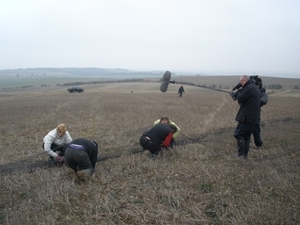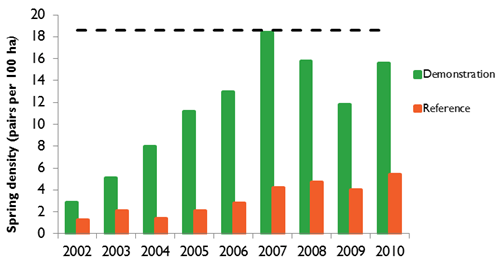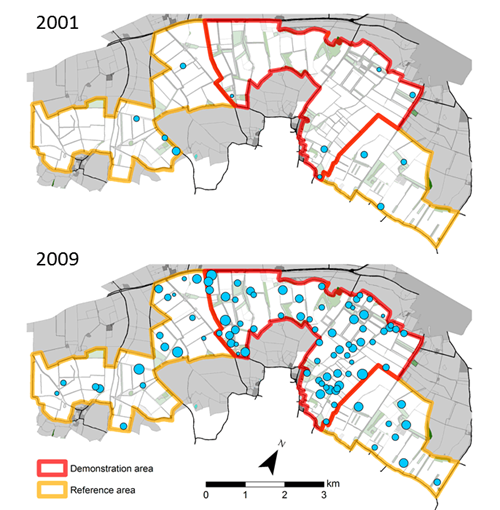 The Grey Partridge Recovery Project ran from 2002 to 2010 on area of rolling farmland near Royston, Hertfordshire. As lead partner for the grey partridge under the UK government's Biodiversity Action Plan, we established the project to convince land managers that restoring numbers of wild grey partridges is possible in a modern farming environment. To demonstrate how this could be achieved by implementing our management recommendations, we set a target spring density of 18.6 pairs per 100ha - whilst maintaining profitable farming.
The Grey Partridge Recovery Project ran from 2002 to 2010 on area of rolling farmland near Royston, Hertfordshire. As lead partner for the grey partridge under the UK government's Biodiversity Action Plan, we established the project to convince land managers that restoring numbers of wild grey partridges is possible in a modern farming environment. To demonstrate how this could be achieved by implementing our management recommendations, we set a target spring density of 18.6 pairs per 100ha - whilst maintaining profitable farming.
In order to reach this target on our 1,000ha demonstration area, three key types of management were undertaken:
- Control of partridge predators, including egg predators
- Habitat improvement and creation, designed to provide nesting, brood rearing and winter cover
- Supplementary feeding in both summer and winter
Intensive grey partridge counts were carried out in March (spring pair counts) and just after harvest (autumn counts) across the demonstration area, recording the sex of all grey partridge adults as well as the number of young birds present in each covey in the autumn. In addition, we also counted an adjacent 1,000ha reference area where there was no intensive predation control or habitat management directed specifically at partridges. This reference area provided a comparison for how our management compared relative to farmland in general.
Spring counts were conducted in 2002, before any management was put into place, to give baseline densities of 2.9 pairs per 100ha on the demonstration area and 1.3 pairs per 100 ha on the reference area. The density of grey partridge pairs on the demonstration area increased year on year from 2002-2007, when it peaked at 18.4 pairs per 100 ha – falling just short of our target density of 18.6 pairs per 100ha (Figure 1).
However, declines in spring densities were recorded on the demonstration area in both 2008 and 2009, with figures of 15.8 and 11.8 pairs per 100ha respectively, before climbing back to 15.6 pairs per 100ha in the final spring count in 2010.
Figure 1: Spring pair densities (pairs per 100ha) on the demonstration and reference areas for each year of the recovery project. The dashed line represents the target density for the demonstration area set at the beginning of the project

Autumn densities of grey partridges also increased dramatically on the demonstration area following the introduction of our management techniques. From a starting level of 7.6 birds per 100ha in 2001 (compared to less than the 8.1 birds per 100ha recorded on the reference area), autumn densities reached a peak of 87.8 birds per 100ha in 2006 and remained above 70 birds per 100ha in every year until the final autumn count in 2009. Densities on the reference area also peaked in 2006, although at a much lower value of 25.9 birds per 100ha.
In the final autumn count of 2009, 67 grey partridge broods were counted compared with just 5 broods recorded in 2001 before any management was in place (Figure 2). The number of broods on the reference area also increased, from 7 in 2001 to 25 to 2009, although less dramatically than the increases seen on the demonstration area.
Figure 2: Distribution of grey partridge broods across the study area in the baseline count (2001) and final autumn count (2009). The number of young per brood is represented by the size of the circle

The project demonstrated convincingly that it is possible to restore wild grey partridge numbers to over 15 pairs per 100ha within a modern farming environment, despite falling just short of the original density target. As well as increasing numbers of grey partridges, the management practices implemented provided benefits for wider farmland biodiversity.
Further reading
- Aebischer, N.J. & Ewald, J.A. (2012). The grey partridge in the UK: population status, research, policy and prospects. Animal Biodiversity and Conservation, 35: 353-362.
- Aebischer, N.J. & Ewald, J.A. (2010). Grey Partridge Perdix perdix in the UK: recovery status, set-aside and shooting. Ibis, 152: 530-542.
- Sotherton, N.W., Aebischer, N.J. & Ewald, J.A. 2010. The conservation of the Grey Partridge. In: Maclean, N. (ed.) Silent Summer: The State of Wildlife in Britain and Ireland: 319-336. Cambridge University Press, Cambridge.
- Aebischer, N.J. (2009). The GWCT Grey Partridge Recovery Programme: a Species Action Plan in action. In: Cederbaum, S.B., Faircloth, B.C., Terhune, T.M., Thompson, J.J. & Carroll, J.P. (eds) Gamebird 2006: Quail VI and Perdix XII: 291-301. Warnell School of Forestry and Natural Resources, Athens, USA.
- Aebischer, N.J. & Ewald, J.A. 2004. Managing the UK Grey Partridge Perdix perdix recovery: population change, reproduction, habitat and shooting. Ibis, 146 Supplement 2: 181-191.